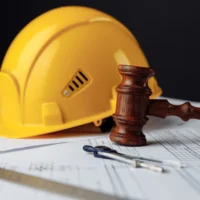Fatal Accident in Queens on Monday Serves as a Tragic Reminder of the Dangers of Falling Objects in Construction Work

A tragedy struck a construction worker in Queens on Monday. According to a police account reported by WNYC non-profit local newsroom Gothamist, 54-year-old Paulo Couto was working on an underground water sewage system when he was hit in the head by a falling piece of equipment. The fatal accident took place in Astoria around 31st Street and 34th Avenue mid-morning on October 8. Sadly, Mr. Couto was killed in the incident and pronounced dead by first responders when they arrived on the scene. These are all the details of the incident that are known at this time, but the police continue to investigate how and why the accident occurred.
Being struck by a falling object is one of the leading causes of death in the construction industry. The Occupational Safety and Health Administration (OSHA) has deemed so-called “struck-by” accidents as one of the “fatal four” hazards most likely to befall construction workers. They are second only to falls among the most frequent causes of construction worker deaths.
The risk of death from falls and falling objects is so prevalent and dangerous in the construction industry that New York has enacted a one-of-a-kind law aimed at preventing these kinds of accidents. Known familiarly as the Scaffold Law, New York Labor Law section 240/241 provides the means to hold property owners, agents and contractors absolutely liable for gravity-related injuries and deaths.
The Scaffold Law, section 240(1), applies to “all contractors and owners and their agents, except owners of one and two-family dwellings who contract for but do not direct or control the work.” The law covers a broad range of construction-related activities, including the “erection, demolition, repairing, altering, painting, cleaning or pointing of a building or structure.”
The duty imposed by law requires owners and contractors to “furnish or erect, or cause to be furnished or erected for the performance of such labor, scaffolding, hoists, stays, ladders, slings, hangers, blocks, pulleys, braces, irons, ropes, and other devices which shall be so constructed, placed and operated as to give proper protection to a person so employed.”
Section 240 goes on to impose certain requirements on certain scaffolding, including weight-bearing requirements, railings, fasteners, and limitations on openings, and protects workers if they fall from a height or get struck by falling objects.
Labor Law section 241, meanwhile, applies to construction, demolition or excavation and imposes requirements regarding flooring or filling as the building progresses. The law requires planking and mandates that shafts or openings on each floor be enclosed or fenced to prevent falls. Section 241(6) broadly states that “all areas in which construction, excavation or demolition work is being performed shall be so constructed, shored, equipped, guarded, arranged, operated and conducted as to provide reasonable and adequate protection and safety to the persons employed therein or lawfully frequenting such places.”
Owners and contractors who violate these laws can be held absolutely liable for injuries or deaths that occur in any gravity-related incident. This includes falls and being struck by falling objects, as well as being struck by flying, swinging or rolling objects that occur due to a height differential. Absolute liability means that the injured worker or family of a deceased worker does not have to prove negligence or fault to recover compensation or be limited to receiving only workers’ compensation benefits. These cases are still legally complex, however, and legal representation is recommended to press a successful claim against a property owner or contractor.
New York first enacted the scaffold law in 1885, yet hundreds of construction workers continue to be injured every year, and several workers lose their lives annually as well. Critics of the law claim it unnecessarily drives up construction costs, but what price can be put on worker safety? Construction work is inherently dangerous, but the mandates in the scaffold law present reasonable measures to ensure construction work can proceed in a safe and conscientious manner.
Although nothing can bring back a life lost to a construction accident, hopefully the family of Mr. Couto will be able to find some measure of solace, justice and compensation by holding any and all responsible parties accountable for the life that was lost on Monday. Our condolences go out to the Couto family at this time, and we hope they find peace and comfort in the coming days.


